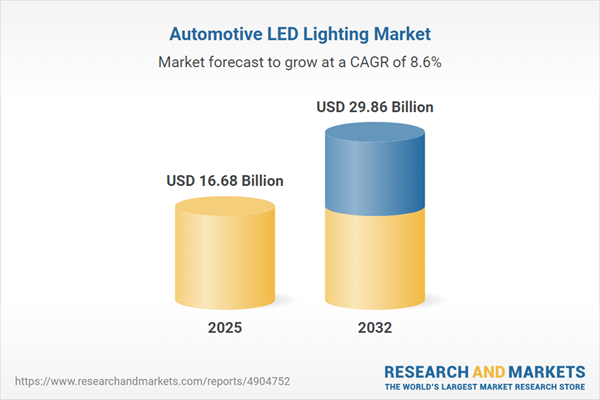Speak directly to the analyst to clarify any post sales queries you may have.
The automotive LED lighting market is undergoing rapid transformation, driven by advancements in vehicle design, energy efficiency, and regulatory standards. Senior decision-makers must navigate a landscape characterized by evolving technologies and shifting supply chain dynamics to maintain a competitive edge.
Market Snapshot: Automotive LED Lighting Market Growth and Opportunity
The Automotive LED Lighting Market grew from USD 15.43 billion in 2024 to USD 16.68 billion in 2025 and is projected to maintain robust momentum, expanding at a CAGR of 8.60% to reach USD 29.86 billion by 2032. These trends highlight the sector’s continuous evolution as manufacturers respond to growing demands for smarter, safer, and more energy-efficient automotive lighting solutions. This market's expansion reflects the convergence of electrification, autonomous mobility, and new regulatory frameworks shaping global industry priorities.
Scope & Segmentation
- Vehicle Type: Heavy commercial, light commercial, off-highway vehicles, and passenger cars are key application areas, each with unique lighting needs based on usage, service intervals, and safety requirements.
- Product Type: Exterior lighting includes daytime running lights (DRLs), fog lights, headlights, parking lights, tail lights, and turn signals. Interior lighting encompasses ambient lighting, dashboard lighting, dome lights, footwell lighting, and instrumental cluster lights.
- Technology: Innovations include laser LED, matrix LED, organic LED (OLED), and standard LED formats, each supporting improved efficiency, customization, and adaptive functionalities.
- Sales Channel: Distribution channels consist of aftermarket offerings and OEM (original equipment manufacturer) partnerships, catering to both new vehicles and retrofit markets.
- Region: Coverage spans global markets—Americas (United States, Canada, Mexico, and Latin America), Europe (United Kingdom, Germany, France, Russia, Italy, Spain, Netherlands, Sweden, Poland, Switzerland), Middle East (UAE, Saudi Arabia, Qatar, Turkey, Israel), Africa (South Africa, Nigeria, Egypt, Kenya), and Asia-Pacific (China, India, Japan, Australia, South Korea, Indonesia, Thailand, Malaysia, Singapore, Taiwan).
- Key Companies: Industry participants analyzed include Acuity Brands Lighting, BrightView Technologies, Continental AG, Cree, Hyundai Motor Company, Innotec, Koito Manufacturing, Philips, LG Innotek, Magneti Marelli, Mercedes Benz, Min Hsiang Corporation, Nichia Corporation, Osram Licht AG, Renesas Electronics, Robert Bosch, SG Automotive Group, Stanley Electric, Tata Motors, Texas Instruments, Toyota, Truck-Lite, Valeo, Wipac, and ZKW Zizala Lichtsysteme GmbH.
Key Takeaways for Senior Decision Makers
- The automotive LED lighting market is being reshaped by regulatory pressures for adaptive performance and energy efficiency, driving accelerated investment in next-generation lighting systems.
- Electrified and autonomous vehicles place a premium on LED technologies with superior energy savings, supporting broader sustainability goals and extended vehicle range.
- Supply chains are being reconfigured in response to new tariffs, prompting increased localization and nearshoring to mitigate risks and control costs.
- OEM and tier-one collaborations are fostering rapid innovation, particularly in matrix beam and smart lighting systems that support enhanced safety and brand differentiation.
- Integration of organic LED technologies in interior lighting is creating competitive opportunities to enhance passenger comfort and vehicle personalization.
Tariff Impact: Navigating New U.S. Trade Policies
Recent United States import tariffs, introduced in 2025, have increased raw material and finished product costs for automotive LED lighting. These developments are compelling manufacturers to diversify sourcing, invest in domestic production capabilities, and adopt agile procurement strategies. This shift is also strengthening regional supply chains but may involve transitional adjustments, including capital investments and operational realignment.
Methodology & Data Sources
This research utilizes interviews with executives across leading OEMs, tier-one suppliers, and aftermarket distributors, complemented by secondary sources such as technical journals, regulatory filings, industry publications, and patent landscapes. Analytical techniques include scenario modeling, technology road-mapping, and supply chain mapping, with cross-validation through expert panels to ensure data integrity and reliable forecasting.
Why This Report Matters
- Provides an in-depth segmentation framework for targeted investment and smarter product development strategies.
- Equips industry leaders to proactively manage supply chain risk and tariff exposure within a rapidly changing trade landscape.
- Enables benchmarking of technology adoption, supporting alignment with consumer trends and regulatory requirements in key regional and global markets.
Conclusion
The automotive LED lighting market offers substantial opportunities for innovation across performance, safety, and sustainability. Stakeholders who align R&D initiatives and supply chain strategies with evolving market demands will be well positioned for growth and resilience in an increasingly competitive sector.
Additional Product Information:
- Purchase of this report includes 1 year online access with quarterly updates.
- This report can be updated on request. Please contact our Customer Experience team using the Ask a Question widget on our website.
Table of Contents
3. Executive Summary
4. Market Overview
7. Cumulative Impact of Artificial Intelligence 2025
Companies Mentioned
The companies profiled in this Automotive LED Lighting market report include:- Acuity Brands Lighting, Inc.
- BrightView Technologies, Inc.
- Continental AG
- Cree, Inc.
- Hyundai Motor Company
- Innotec, Corp.
- Koito Manufacturing Co. Ltd.
- Koninklijke Philips N.V.
- LG Innotek Co., Ltd.
- Magneti Marelli S.P.A.
- Mercedes Benz
- Min Hsiang Corporation
- Nichia Corporation
- Osram Licht AG
- Renesas Electronics Corporation
- Robert Bosch GmbH
- SG Automotive Group Co Ltd
- Stanley Electric Co., Ltd.
- Tata Motors Limited
- Texas Instruments Incorporated
- Toyota Motor Corporation
- Truck-Lite Co., LLC
- Valeo SA
- Wipac Limited
- ZKW Zizala Lichtsysteme GmbH
Table Information
| Report Attribute | Details |
|---|---|
| No. of Pages | 194 |
| Published | November 2025 |
| Forecast Period | 2025 - 2032 |
| Estimated Market Value ( USD | $ 16.68 Billion |
| Forecasted Market Value ( USD | $ 29.86 Billion |
| Compound Annual Growth Rate | 8.6% |
| Regions Covered | Global |
| No. of Companies Mentioned | 26 |









